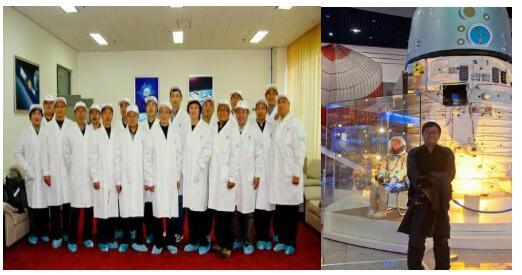In order to improve the appearance recognition of the product, our company has decided to upgrade the packaging of HFV vacuum pump oil 4L from May 5, 2023.
 May. 05,2023
May. 05,2023  Current location: Home > News > Company News > Learn the spirit of aerospace and connect with aerospace technology
Current location: Home > News > Company News > Learn the spirit of aerospace and connect with aerospace technology 
On December 17, 2012, the Chinese Vacuum Society carefully organized a series of "China Association for Science and Technology Member Day" activities, including visiting China Aerospace City and awarding prizes to outstanding scientific and technological workers across the country. "China Association for Science and Technology Day" is a festival for the vast number of scientific and technological workers in my country, as well as a festival for the vast number of scientific and technological workers of the Chinese Vacuum Society. It is a festival that advocates scientific spirit and innovative culture. In order to combine learning the spirit of the 18th CPC National Congress, feel the great achievements and rapid development of my country's aerospace industry, and make suggestions for vacuum technology to serve the country's five major constructions and the great cause of a well-off society, Hou Jianguo, member of the Standing Committee of the National People's Congress, President of the University of Science and Technology of China, Chairman of the Chinese Vacuum Society, and Chairman of the Chinese Academy of Sciences, and Professor Chen Xu, Vice President of Tsinghua University and Secretary General of the Chinese Vacuum Society, led a group of more than 20 scientific and technological workers to visit the China Aerospace City located in the northwest suburbs of Beijing.
We visited the China Astronaut Research and Training Center with excitement. This is where all Chinese astronauts, including space heroes Yang Liwei, Fei Junlong, and Nie Haisheng, were born and grew up. Professor Chen Shanguang, director of the center, introduced us to the overall situation of the China Astronaut Research and Training Center. The center is a comprehensive research institution combining medicine and engineering in the field of manned space flight in my country. It has the National Key Laboratory of Basic and Applied Space Medicine and the National Defense Science and Technology Key Laboratory of Human Factors Engineering. It undertakes many important tasks such as astronaut selection and training, medical supervision and medical support, spacecraft environmental control and life support system development, space suit and space food development, large-scale ground simulation test and training equipment development, and has made outstanding contributions to the successful completion of my country's manned space flight. Here, we visited the manned space flight engineering series exhibition, the Shenzhou spacecraft ground simulation training system, Asia's largest simulated weightlessness training tank, and my country's self-developed extravehicular space suit system, and we were in awe. What made us even more excited was that two heroic astronaut heroes, Liu Wang and Liu Yang, who had successfully flown into space with the Shenzhou 9 manned spacecraft, came over and happily took a photo with us, becoming a moment that we will always treasure in our hearts.
We continued to attend the Beijing Aerospace Flight Control Center, which has attracted the attention of the world many times, and we have seen its internal scenes on the phone screen many times. From the Shenzhou series of spacecraft to Tiangong-1, from Chang'e-1 satellite to the lunar exploration project, it has successfully completed six "Shenzhou" spacecraft flight control missions and satellite command and support missions. It is the first in China and the third in the world to have transparent control capabilities, visual measurement and control and command capabilities, high-precision real-time orbit determination capabilities, multi-type data fusion processing capabilities, and automated flight control capabilities.
China Academy of Space Technology is the main research center for China's space technology and a base for the development and production of spacecraft. Yan Rongxin, Researcher and Director of Vacuum and Leakage Detection Technology Research Laboratory of General Assembly and Environmental Engineering Department, and Chairman of Mass Spectrometry and Leakage Detection Professional Committee of China Vacuum Society, first led us to visit the China Aerospace Exhibition Hall, where we saw the model of Dongfanghong-1 satellite, the earliest satellite launched by China, and heard the familiar melody of "Dongfanghong" transmitted from the satellite. Models of Dongfanghong-3 and -4 satellites, as well as China's first recoverable satellite, are also on display here. China Academy of Space Technology has developed and successfully launched many different types of artificial satellites, unmanned test spacecraft and manned spacecraft, and has initially formed a series of recoverable remote sensing satellites, Dongfanghong communication and broadcasting series, Fengyun meteorological satellite series, practical scientific exploration and technology test satellite series, earth resources satellite series and Beidou navigation and positioning satellite series, achieving remarkable achievements.
Finally, we visited the plant and workshop of the General Assembly Department of the China Academy of Space Technology, the assembly and testing and sealing leak detection work line of the spacecraft, and also saw the important role of vacuum technology in the field of aerospace technology. Our scientific and technological workers of the Chinese Vacuum Society feel both honor and responsibility, and strive to make their own contributions to the further integration and development of vacuum technology and aerospace technology.
Platform Information Submission-Privacy Agreement
· Privacy Policy
No content yet